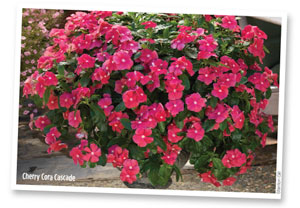5/15/2009
Success With Cora and Cora Cascade
Dr. David Koranski

Landscape use and field trials have shown that Cora vinca and the new Cora Cascade vinca have a high tolerance to aerial Phytophthora. But experienced growers know just because a variety thrives under environmental challenges, it doesn’t eliminate the need for common-sense growing practices. Growing “best practices” can help eliminate other greenhouse disease issues such as Thielaviopsis and Pythium that commonly affect vinca and most other bedding plants.
1. Provide a well-aerated media. Plants finished in areas with protection from
seasonal rains and
adequate dry back within 18 to 24 hours (Saturated 5–Medium 2) will be less susceptible to root disease.
2. Maintain an EC range of 1.2 to 2.0 to finish plants. An EC less than 1.2 will stress plants and may cause
susceptibility to disease; EC greater than 2.0 in a dry substrate for longer than four to eight hours could result in iron-
deficient plants with stunted roots and shoots.
3. A slow-release fertilizer can be added. Plants treated with slow-release fertilizers should not be allowed to dry down. Dry down could result in iron-
deficient plants with stunted roots and shoots.
4. Provide a pH no greater than 5.5. With a pH greater than 5.5, vinca may become susceptible to Thielaviopsis, creating an environment for secondary infections such and Phytophthora and Pythium.
5. Monitor pH weekly. Vinca can raise the pH of the growing substrate by as much as one unit in 10 to 14 days.
6. Take action. If Thielaviopsis is prevalent in your greenhouse, treat plants with a preventative during the first seven days after transplant.
7. Soil temperatures. Grow vinca in soil temperatures no less than 70F (21C) day and night: an average daily temperature of 80F (26.7C) is optimum.
8. Grow vinca in humidity of 40% to 70%. If growing in greenhouses, avoid many foliage diseases such as Botrytis and Rhizopus with horizontal fans to lower humidity to 40% to 70%.
Review and employ methods to eliminate Thielaviopsis.
• pH 5.5
• If this disease has infected your greenhouse, maintain an EC less than 1.5
• Use a preventative fungicide following label directions
• Maintain phosphorus less than 12 ppm
• Maintain ammonium less than 10 ppm
9. Fertilize. Fertilize with iron at 2 ppm and ammoniacal nitrogen at 20% if light intensity is greater than 5000 foot candles (18 mols), on a trial basis.
10. Diagnose. Use a reputable plant lab to diagnose problems so an effective treatment plan can be applied.
11. Containers. Only use new plug trays and finish containers.
Dr. David Koranski is a consultant for bedding plant growers worldwide and the president of ETA, Inc.